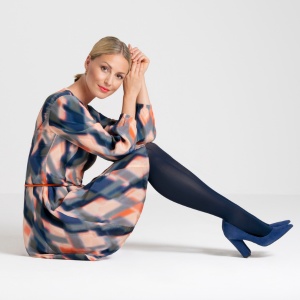We’re revealing the secret to comfortable legs – compression stockings! Find out more about our high-quality circular-knit stockings such as Memory, Memory Aloe Vera, Memory Men, Lastofa Verde, Lastofa, and Lastofa Cotton.
For edema patients, we offer our flat-knit compression stockings Lastofa Forte with merino wool.
What does compression mean exactly?
The word ‘compression’ essentially means ‘pressing together’. The technical term for medical compression is derived from this and stands for mechanical pressure which is applied to a specific part of the body. Compression therapy can either be used preventively (with sports, for example) or to treat acute diseases. Compression is predominantly seen in the form of tights or stockings. Ofa also offers compression supplies for arms and hands.
Depending on the vascular disease at hand and the extent of its impact, different types of compression is used in medicine (flat-knit vs. circular-knit). Additionally, compression classes are divided into different degrees of severity.
Compression for vein disorders
To treat vein disorders, doctors often prescribe compression stockings. The compression pressure applied by the tight stockings ensure that the venous valves close and speed up the pumping of blood back to the heart. What’s more, it allows metabolic waste to be removed more quickly and thus reduces swellings.
Compression for edema
When treating edema (accumulation of water), pressure is applied to the entire lymphatic system through compression. This activates ‘decongestion’, ensuring that water retention can flow off better and more quickly. In the case of conditions like lipedema or lymphedema, compression stockings are an integral component of medical therapy.
Unlike compression stockings, support stockings only have a preventive effect. When sitting down or standing for a prolonged period, such as when the legs get heavy and swell up while travelling, support stockings can provide relief. They do not help if a medical indication already exists.
The benefits of compression stockings
It is not only the veins that benefit from wearing compression stockings. Other factors that can be improved through compression are:
- Better lymph and blood flow
- Reduction of swellings
- Faster regeneration
- Relief from strain on the legs
- Prevention of injuries
- Stabilisation of ligaments and tendons
What does compression help with?
Every registered doctor can prescribe compression stockings. They are often used to treat the following conditions:
- Thrombosis
- Varicose veins
- Weakness of the connective tissue
- Lipedema
- Lymphedema
- Edema caused by pregnancy
- Chronic venous insufficiency

Compression for quick recovery after exercising
Compression stockings can improve blood circulation and, thereby, supply the muscles with oxygen faster. As a result, an athlete will have more energy and will be able to increase their performance more quickly. What’s more, compression stockings reduce muscle twitching, which can lead to more stability, better self-awareness and, thus, a lower risk of injuries.
The use of compression in sports predominantly serves regeneration. Athletes tend to recover more quickly after a workout if they’re wearing compression stockings and sore muscles are subjectively perceived as less intense.
Compression for the prevention of thrombosis while travelling
Long flights and the respective sitting in a confined space is particularly strenuous for the legs. When combined with other risk factors such as smoking, excess weight, or a genetic predisposition to varicose veins, it can lead to travel thrombosis. This occurs when the legs aren’t used for several hours; blood flow in the veins is reduced and the legs swell up. The calves can also begin to hurt. Both can be the first signs of thrombosis. For these reasons, if you suffer from vein diseases, you should not forget your compression stockings.
Circular-knit or flat-knit – what’s the difference?
Depending on the condition, either circular-knit or flat-knit stockings are recommended. Generally, the following rules apply:
- Circular-knit compression for vein disorders: These are especially elastic, both vertically and horizontally, which means that they are very stretchy lengthwise as well as crosswise. As such, they are easier to put on. Circular knitting machines work with a round cylinder that contains between 300 and 520 needles. The number of needles remains constant throughout the entire knitting process, whereas the stitch sizes vary and different circumferences can be knitted for one stocking. This type of compression stocking applies light to medium-strong pressure.
- Flat-knit compression for edema (such as lipedema or lymphedema): Flat-knit compression stockings are less elastic lengthwise and crosswise compared to circular-knit stockings (the only exception is Lastofa Forte). They are, thus, barely stretchy and are perfectly fitted to the patient’s measurements. Flat-knit compression applies particularly high pressure. The flat-knit stocking is produced in different individual components, which are then sewn together with a seam.

Compression Classes I - IV
Apart from the distinction between flat-knit and circular-knit, there are also compression classes which determine the intensity of the pressure applied. The individual compression class most suitable is decided by a medical professional. As a general rule, the worse the condition, the higher the pressure to be applied.
There are four pressure classes:
- Class 1: Heavy legs, no edema, minor cases of varicose veins
- Class 2: Swellings, edema, prominent varicose veins
- Class 3: Chronic venous insufficiency, thrombosis, open wounds
- Class 4: Lipedema, lymphedema
Compression stockings: Putting them on and care
Compression stockings must sit very tightly and should ideally feel like a ‘second skin’. That’s why putting them on can often be a little challenging. Rubber gloves and donning aids can help to pull the stockings over the legs more easily. Skincare is also really important to prevent dryness of the skin. Additionally, washing of the compression stockings daily – either by hand or at 30 degrees Celsius on a gentle cycle - is extremely important as cleaning the stockings will maintain their elasticity.
This might also be of interest:






